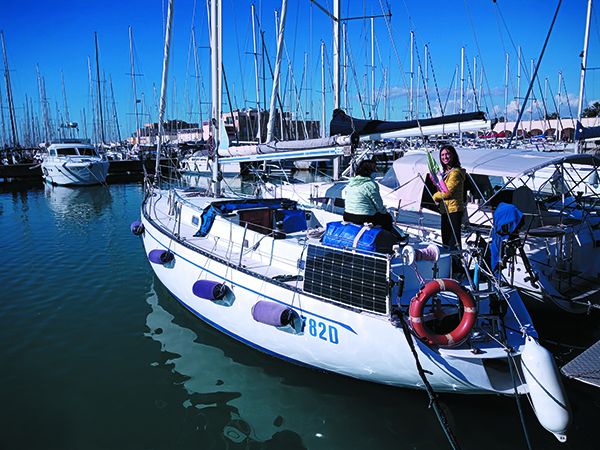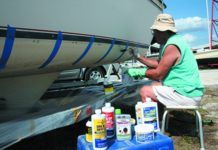Roller Furling
My name’s Gabriel, I’m American-Italian and I live in Rome. My boat is a Classis 35 Lady Laura built in 1982 by Classis, a shipyard had started working in the 1960s. The Lady Laura designs were relatively successful, but following the Italian economic crisis of the early 1980s they shut production down in 1984.
I was reading about your plans to update your last report on furling mainsail systems (“In-boom furling—five-systems,” PS October 2001) and had some questions about mine. I’m pretty sure my Hood Stoboom is as old as the boat. Basically, it is a rolling boom attached to a second fixed boom below it and driven by a endless line furler.
It works fine in my case, but I’ve only used it in winds up to 20-knots. Above that, I roll it down, so I can’t say how it behaves in more extreme conditions. In normal situations, it works very well. It makes raising the sail and lowering it very easy, and it allows me to do it on my knees if I want too, which I feel is safer in rough seas.
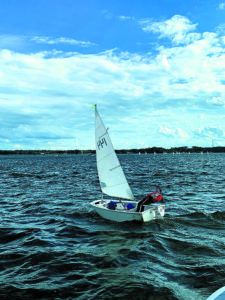
Florida. Her father Art had questions about sailing helmets.
The one thing I don’t like is the ‘underboom’ which you can see in the picture. It’s rectangular, heavy and I worry about someone being hit by it, so I think it requires the use of a retainer and/or boom brake. But I don’t know whether it was standard with the Stoboom or it is just my boat. To lower the sail you must head to the wind, give the mainsail sheet some slack, and keep some tension on the halyard to prevent it from coming down too quickly.
If the endless line needs to be re-rove, it can be a bit problematic to create the splice. Even if you get it right, it’s hard to gauge the right length. There are a number of notches that allow you to tension the line but if you are unlucky it will fall between two holes, one of them being unreachable and the top one leaving the line too slack. In our case, rather than redo the whole thing, we added a piece of cork to provide the right tension. Not ideal but it works.
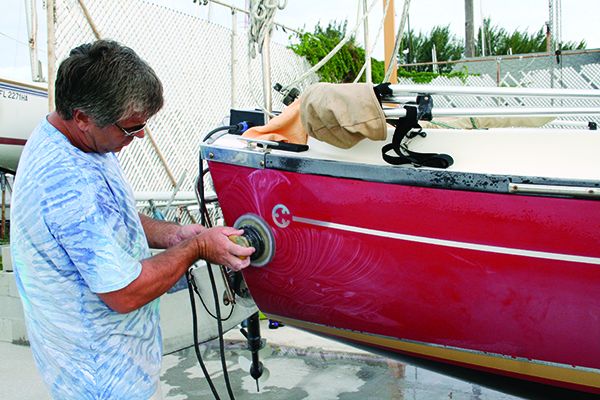
One of the most common questions we get from new owners of old boats is how to bring back new gelcoat shine. We’ve undertaken countless product tests to find the best boat wax and polishes, the most effective waxing-and-polishing tools, and the products that can be used for a speedy touchup.
You’ll find a good overview of our archive articles on this topic in the May 12, 2015 blog post, “A Practical Look at Waxing and Polishing Your Boat.” We reported on our tests of paste waxes in the February 2009 issue, one-step cleaner/waxes in the March 2007 issue, and aggressive rubbing compounds (for those much-weathered hulls) in the April 2014 issue. For those looking for a quick and easy way to add a little shine to your hull, without the full-on protective-wax routine, be sure to read our report on spray-on waxes in the December 2014 issue. If your hull is looking a little long in tooth and needs more than a wax job, consider a gelcoat restorer (see PS July 2011 online), but weigh the pros and cons first.
Readers will find helpful information on what tools we recommend for restoring and protecting gelcoat in the March 18, 2014 blog, “The Pro’s Guide to Restoring Gelcoat,” as well as our test report of the Shurhold Dual-Action Polisher in the April 2010 Chandlery section.
If you’re serious about protecting your investment and prefer to have all your research in one, easy-to-access place, then consider buying PS’s “Gelcoat Restoration and Maintenance” ebook, or the whole maintenance series, “Marine Cleaners.”
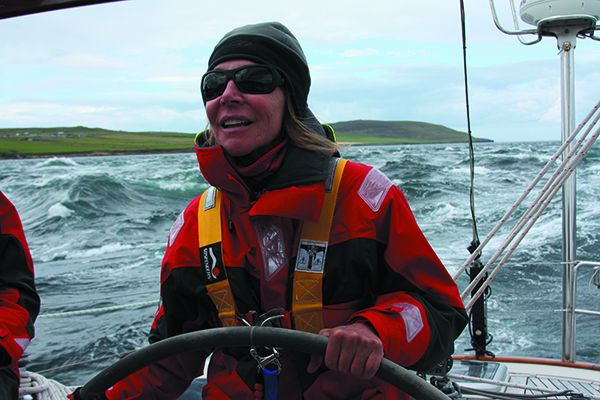
Safety At Sea
Our archives are overflowing with safety gear tests and tips articles. Here are a few that are timely—and timeless. Check out our tests of safety tethers (PS September 2011) and PFD-harnesses (PS July 2013 and August 2008), and the feature on life-raft inspections (February 2013). In 2012, we reported on three racing accidents, each with important lessons for all sailors: WingNuts capsize (April 2012), Rambler 100 capsize (May 2012), and the Low Speed Chase (Farallones) capsize (June 2012). And in “Practical Tips for Survival at Sea” (June 2013), author Michael Tougias offers advice from survivors on what they would have done differently and what helped them survive.
For a compilation of decades of PS safety tests and advice articles, check out the “MOB Prevention and Recovery” ebook, which is available from our online bookstore www.practical-sailor.com/books.
Gabriele Poole
Classis 35 Lady Laura Carlotta IV
Ostia, Rome
We’ve reached out to Joe “Coop” Cooper (www.joecoopersailing.com), sailing consultant, former sailmaker at Hood, and member of the winning 1980 Australian America’s Cup Team for some insight, and here’s what he had to offer:
“My memory is that the mandrel was captured inside what amounts to a canvas shell. There were fittings fore and aft that carried the bearings for the mandrel and to which was attached the canvas cover If you visualize say a 15-inch diameter tube made of canvas, then slit it lengthways and put some supporting tubes, ribs, fore and aft along it and mount this to the fore and aft fittings on the ‘Boom” you are on the right track [to recreating the old assembly]. If it is working after 35 years, that ain’t bad. Better than the sails, the engine and all the electronics. Your biggest problem if you want to keep this beast going is (not) getting spares for it. Hood Yacht Spars in the UK, the last owners, went under in about 2005-2006 or so and sank without trace. For my money, in the mainsail sail handling stakes, either bite the bullet and just use flat (or round as needed) slug slides and regular battens. If you want everything led back to the cockpit—a not necessarily good idea anyway—put on a Harken track and call it quits.
Sailing Helmets
Thank you for your comprehensive summary on sailing helmets (see “Protecting the Sailors Pumpkin, PS July 2018, and “Superlight Sailing Helmets,” PS November 2019). I have a few clarification questions, how many joules is getting hit in the head with a boom on a racing dinghy? Why do the bike helmets have a rating of 100 joules vs. 12.8 for sailing helmets? Is getting hit in the head by a boom more than 12.8 joules? I’m letting my 12-year-old daughter compete in a dinghy regatta this weekend, and I would get her a sailing helmet versus a bike helmet, except for the fact that 12.8 joules sounds like minimal protection. What am I failing to understand here? By the way, my dad subscribed to your publication for many years, and I grew up sailing in the 1980s and ’90s with my parents aboard their O’Day 39 out of Huntington, Long Island and later Stamford, CT.
Art Maroney
Stamford, CT
The table data we used for the helmet report is based on industry test results used for certification and the test methodology is different for bicycles, so comparing the two numbers is an apples and orange comparison. The kayaking/sailing helmet will provide better protection for sailing, where side impacts are most common.
Sailing helmets are so new that there is no standard strictly for sailing. Instead, the standard that applies to racing sailing is adopted from helmets for other sports. Most dedicated sailing helmets meet EN 1385, a standard developed for whitewater kayaking.
One could use a helmet designed for other sports, but some are poorly suited for sailing. Construction helmets (hard hats) can protect against strikes at the top of the head, but the crown is typically 1.5-inches high and they aren’t designed for side impact. Bicycle helmets are light and protect against hitting the ground, but they offer less side coverage and can snag. Mountaineering and rescue helmets are tested with two to four times greater impact energy, but may be more bulky. Currently our favorite helmet is the Kong Leaf, which is lighter than all the designs we previously tested.
There are also bump caps inserts that might provide enough protection if your daughter is reluctant to wear a helmet. Given the low risk of serious head injury sailing a small dinghy in light winds, this might also be a good option. Most good instructors instill an inordinate amount of caution in students regarding the boom.
A helmet only works if you wear it, and for most day sailors and cruisers, it would take very special circumstances (heavy weather or a trip up the mast) to make us pull one on.
It is important to note that bump caps are not hardhats or helmets by any stretch of the imagination. Although approved under a standard (EN 812), their only purpose is to protect workers from minor bruises and scalp injuries from static objects when working in areas with low ceilings and low hanging obstructions. There are even inserts that can be slipped inside you favorite hat.
Bump caps won’t offer much protection against a hard whack, but they are convenient for cruising sailors who are tired of getting welts from colliding with the companionway.
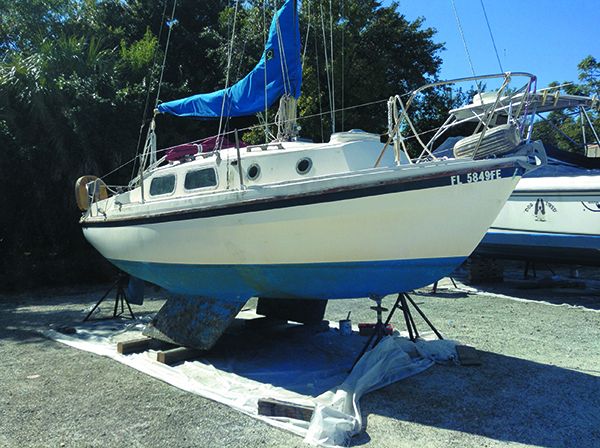
trait for the Gulf Coast of Florida, where shallow bays and passes are the norm.
Bilge Keel
Regarding your recent request for information on bilge keel boats (see Inside PS blog, “What is the Best Keel for a Shoal Draft Boat?), I’m a twin-keel sailor in South Florida. I’ve owned and sailed four bilge keel boats, a Vivacity 20, a Westerly 25, and a pair of 23-foot Westerly Pageants. I’m based in Sarasota, on the west coast where the Gulf waters are warm and blue, but the estuarine waters are brown and shallow.
Here are the advantages of a bilge keelers I’ve sailed:
Stiff – With a roughly 40% ballast ratio, the boats are stiff and can handle real wind without extreme heel.
Shallow draft – The Vivacity drew 2 feet, and the Pageant is 2’10”. And both can be run aground without fear. This makes gunk holing an adventure instead of a peril. And no underwater parts to break or shear.
Maintenance – Pull up on a scenic sandbar and scrape the bottom, a fun summertime enterprise. Just don’t forget to figure out the tides.
Stability – One of the Pageants had a vane-only self steering device, with no pendulum or auxilliary rudder in the water. It once made the 48 hour trip from Sarasota’s New Pass to the Dry Tortugas entirely on the vane. A sheet-to-tiller system is almost as reliable, although with more variation due to “system” lag.
Volume – By their nature, twin-keep designs are beamier than similar-sized single-keel designs. This provides separation for the keels. Thus interior space is larger, with more storage bins etc.
Strength – Most twin-keel boats are British, and are built for use in areas with large tidal ranges. Slips must accommodate serious water level changes, and are expensive to rent. Many twin-keelers regularly “take the bottom” on their moorings, day after day after day, with all the associated pounding.
Dry – All four of my boats had bilge spaces so dry I could store postage stamps there. Finding water in the bilge was a rare event, usually due to leaving a port or hatch open in a rain. With a dry bilge, mildew was held at bay if you had some through-cabin ventilation.
Posture – Sits upright when in the boatyard; no jack stands required. Much better stability on a trailer (use a flatbed if you want).
Some of the disadvantages:
Speed – More wetted area, so slower. Over the very long haul, I average about 3 knots for planning purposes. Mind you, waterline length is about
17 feet.
Pointing – Doesn’t sail well at the “edge” going to windward. Performs best about 50-55 degrees of the wind.
Barnacles – With more underwater surface, more opportunity for barnacles to grow.
Racing potential – Last place every time.
For family sailing and cruising, we’ve found bilge keelers to be an obvious choice for southwest Florida. They are blue-water capable, but shine in shallow waters. Roomy, airy, comfy. All boats are compromises, and sailors should be serious about what they want to accomplish. My Pageants were designed to take a family of four across the English Channel for a visit to France. While France is a long way from Sarasota, they continue to be seaworthy and sea-kindly cruisers.
Stan Zimmerman
La Sirene, 970 Westerly 23 Pageant. Sarasota, FL
Practical Sailor welcomes reader comments and questions. Send email & reader photography (digital .jpeg 1MB or greater) to [email protected]; include your name,homeport, boat type, and boat name. Send Gear Graveyard samples to PS at 1600 Bayshore Rd., Nokomis, FL 34275






























